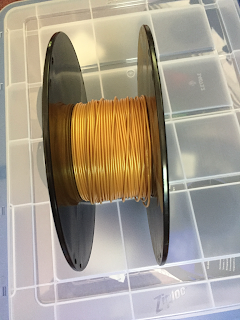Like most beginners, when I started 3D printing I did not realize the importance of properly storing my filament however living in a humid state like Florida I ended up learning the importance first hand. In this post I will discuss how I store my filament and why it is important to properly store your filament.
My problem started when I bought several different colors of filament that I wanted to use for different projects. As I would finish a project I would stack the remaining filament in a pile under the desk that I had my printer on. Everything started out printing great however over time I started noticing that I was having problems printing with some of the filament. Once I realized that most of the problems I was having came when I was using older filament I started doing some research and realize that humidity can have a big impact on filament and since I live in Florida I figured I needed to properly store my filament.
Living in Florida I do have a central air conditioning unit that keeps my house quite cool and relatively dry (not humid like outside) however humidity still gets in the house each time we open the door or a window. The PLA filament that I was stacking up under my desk would suck up that humidity. This can cause several issues with the filament like brittleness, swelling of the filament and pockets of moisture within filament causing bubbling or hissing of steam. All of this can lead to complications when printing.
I have read and watched numerous videos on how to properly store filament. Some of the ideas seem to be pretty elaborate while others seem to be a pain to use. To be honest using vacuum bags with a desiccant seems like it would work great, do I really want to pull out a vacuum cleaner to seal a bag each time I switch filaments. The answer to that is no. What I do, while it may not work as well as a vacuum sealed bag, works well enough for what I need and is a lot simpler.
I use the Ziploc WeatherShield boxes with silica gel desiccant packets. The Ziploc WeatherShield boxes contain a foam seal that help keep out the humidity that damage the filament. It is also a lot easier to open one of these container to get the filament we need and to put away the filament once we are done with it. The question is, what happens to the moisture that gets in when we open/close the containers. For this I put in a handful of Silica Gel Desiccants packets in each box to remove the moisture from the container.
I am usually able to store two six to eight filament spools in one box depending how the make of the filament. The following images shows how I store the filament in the box.
The lid on the Ziploc WeatherShield boxes has a foam seal which helps keep the damaging moisture out of the box. The following image shows the blue foam in the lid.
The box itself has four snap tight latches which keeps the boxes sealed. The following images shows two of the latches.
This last images shows how shows the box latched up and ready to store.
While there are plenty of other methods to store filament, I have found this method to work real well for me. It gives me easy access to filament when I want it and it also keeps the majority of the damaging humidity out.





Comments
Post a Comment